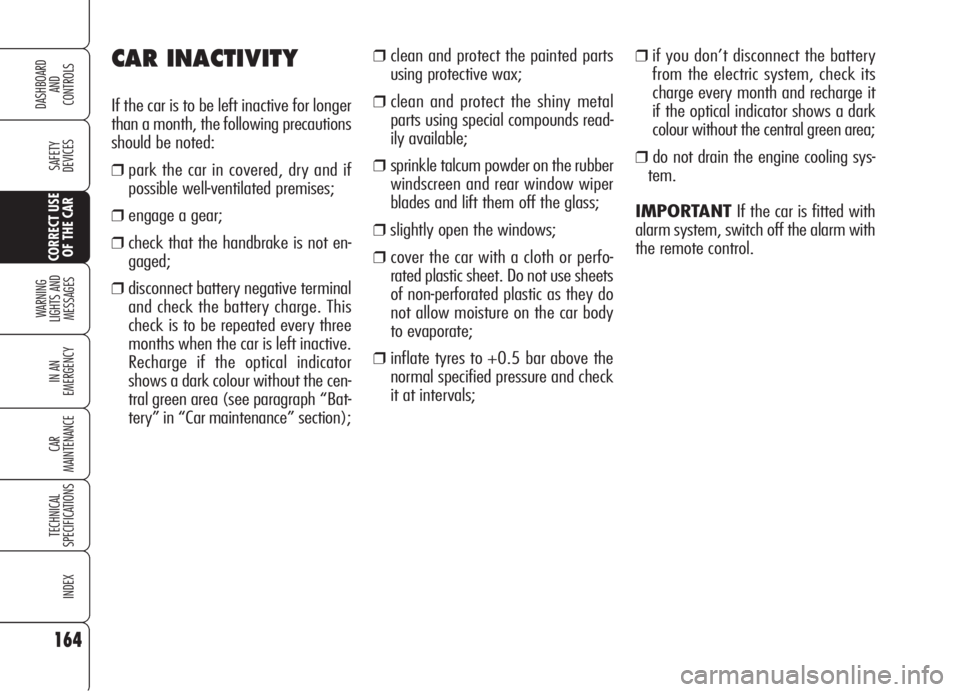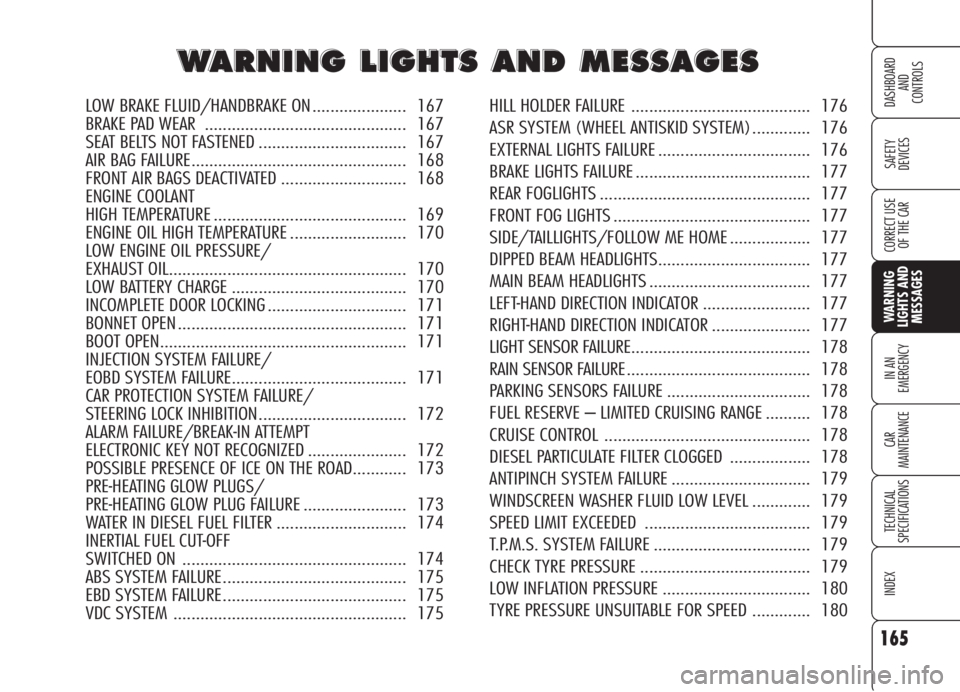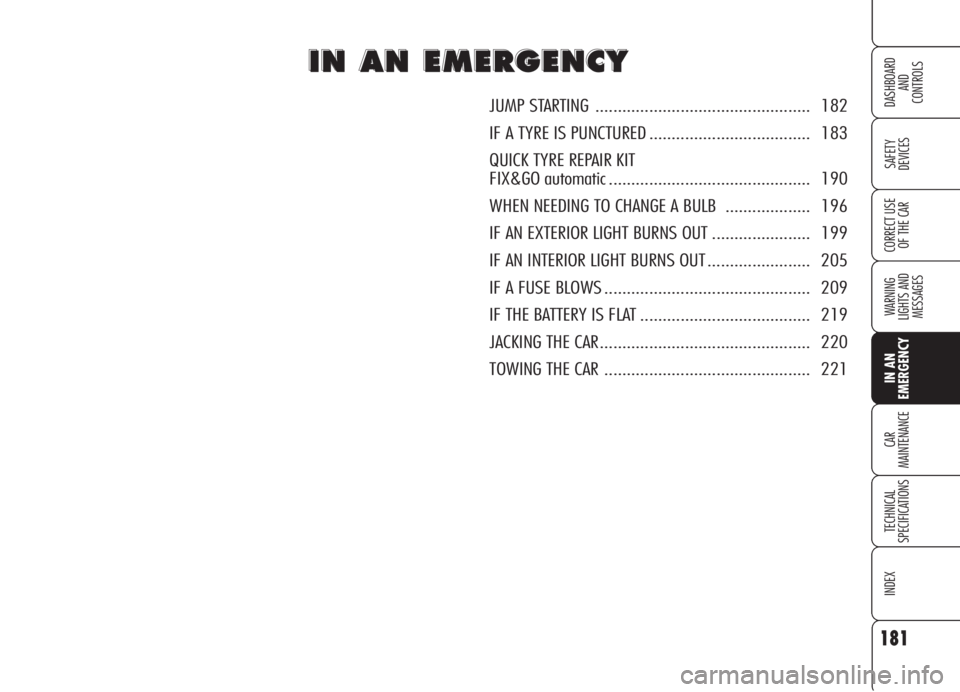battery Alfa Romeo 159 2006 Owner handbook (in English)
[x] Cancel search | Manufacturer: ALFA ROMEO, Model Year: 2006, Model line: 159, Model: Alfa Romeo 159 2006Pages: 299, PDF Size: 4.64 MB
Page 104 of 299

102
SAFETY
DEVICES
WARNING
LIGHTS AND
MESSAGES
IN AN
EMERGENCY
CAR
MAINTENANCE
TECHNICAL
SPECIFICATIONS
INDEX
CORRECT USE
OF THE CAR
DASHBOARD
AND
CONTROLS
OPENING BY REMOTE
CONTROL
Press the electronic key button `.
Opening is indicated by double flashing
of direction indicators.
Opening the boot with alarm (where
provided) on will cause the following:
❒volumetric protection deactivation;
❒anti-raising protection deactivation;
❒tailgate monitoring sensor.
Re-closing the tailgate will restore all the
above functions and direction indicators
will turn on for about 1 second. Emergency opening of the
boot from the passenger
compartment
If the battery is disconnected, the boot
can be opened by pulling the lever A-
fig. 95set under the rear left seat.
Refit the handle under the cushion after
using it.
A0E0228mfig. 95
IMPORTANTAfter disconnecting the
battery or failing the protection fuse, the
tailgate locking/unlocking mechanism
shall be “initialised” again, proceed as
follows:
❒lock the doors and the tailgate;
❒press the remote control button Áor
the button
qon the central console;
❒press the remote control button Ëor
the button
qon the central console.
Page 118 of 299

116
SAFETY
DEVICES
WARNING
LIGHTS AND
MESSAGES
IN AN
EMERGENCY
CAR
MAINTENANCE
TECHNICAL
SPECIFICATIONS
INDEX
CORRECT USE
OF THE CAR
DASHBOARD
AND
CONTROLS
Sound system presetting includes:
❒sound system power cables;
❒front and rear speakers cables;
❒aerial power cable;
❒sound system compartment;
❒aerial on car roof.
The sound system shall be installed in
the proper space occupied by the odd-
ment compartment that shall be re-
moved by pressing the two retaining
tabs set in the oddment compartment:
here you will find the power cables.
SOUND SYSTEM
PRESETTING
(where provided)
When the sound system has not been
requested the car is provided with two
oddment compartments on the instru-
ment panel.
If you decide to install
the sound system after
buying the car, contact
first Alfa Romeo Authorized
Services that will give you use-
ful advice about installation and
how to safeguard the battery.
Excessive loadless absorption
damages the battery and the
battery warranty can be inval-
idated.
Page 119 of 299

117
SAFETY
DEVICES
WARNING
LIGHTS AND
MESSAGES
IN AN
EMERGENCY
CAR
MAINTENANCE
TECHNICAL
SPECIFICATIONS
INDEX
CORRECT USE
OF THE CAR
DASHBOARD
AND
CONTROLS
RADIO TRANSMITTERS AND
CELLULAR TELEPHONES
Radio transceiver equipment (e.g.: e-
tacs mobile phones, HAM radio systems
and the like) shall not be used inside the
car unless a separate aerial is mounted
outside the car.
The use of these devices inside the pas-
senger compartment (without external
aerial) may cause electrical systems
equipping the car to malfunction. This
could compromise car safety in addition
to constituting a potential hazard for the
passengers.
In addition, transmission and reception
of these devices may be affected by the
shielding effect of the car body.
As concerns the use of mobile phones
(GSM, GPRS, UMTS) provided with of-
ficial EC approval, strictly comply with
the instructions given by the mobile
phone manufacturer.
ACCESSORIES
PURCHASED
BY THE OWNER
If after buying the car, you decide to in-
stall electrical accessories that require a
permanent electric supply (alarm, satel-
lite antitheft system, etc.) or accessories
that in any case burden the electric sup-
ply, contact Alfa Romeo Authorized Ser-
vices, whose qualified personnel, besides
suggesting the most suitable devices be-
longing to Lineaccessori Alfa Romeo, will
also evaluate the overall electric absorp-
tion, checking whether the car’s electric
system is able to withstand the load re-
quired, or whether it needs to be inte-
grated with a more powerful battery.
Take care when fitting
additional spoilers, al-
loy rims and non-standard
wheel caps: they might reduce
ventilation of the brakes, thus
their efficiency, during abrupt
and repeated braking, or long
downhill slopes. Make sure
that nothing (mats, etc.) gets
in the way of the pedals when
they are pushed down.
WARNING
Page 162 of 299

160
SAFETY
DEVICES
WARNING
LIGHTS AND
MESSAGES
IN AN
EMERGENCY
CAR
MAINTENANCE
TECHNICAL
SPECIFICATIONS
INDEX
DASHBOARD
AND
CONTROLS
CORRECT USE
OF THE CAR
For the electric connection a unified con-
nector should be used which is gener-
ally placed on a special bracket normally
fastened to the towing device.
For the electrical connection, 7 pin
12VDC connection is to be used (CU-
NA/UNI and ISO/DIN Standards). Fol-
low the instructions provided by the car
manufacturer and/or the tow hitch man-
ufacturer.
An electric brake or other device (elec-
tric winch, etc.), if required, should be
supplied directly by the battery through
a cable with a cross section of no less
than 2.5 mm
2. In addition to the elec-
trical branches, the car’s electric system
can only be connected to the supply ca-
ble for an electric brake and to the ca-
ble for an internal light, though not
above 15W.Assembly diagram fig. 4
The tow hook structure must be fas-
tened in the points shown by the sym-
bol
Øusing a total of 10 M10 screws.
Fastening points (1) shall be fitted with
spacers with 20x4 mm diameter.
Counterplate (2) shall have 5 mm min-
imum thickness.
IMPORTANTIt is compulsory to fas-
ten a label (plainly visible) of suitable
size and material with the following
wording:
MAX LOAD ON BALL 70 kg
After fitting, screw holes shall be sealed
to prevent exhaust gas inlet.
IMPORTANTThe hook should be fas-
tened to the body avoiding any type of
drilling and trimming of the bumper.
INSTALLING THE TOW HOOK
The towing device should be fastened
to the body by specialised personnel ac-
cording to any additional and/or inte-
grative information supplied by the Man-
ufacturer of the device.
The towing device must meet current
regulations with reference to 94/20/EC
Directive and subsequent amendments.
For any version the towing device used
must match the towable weight of the
car on which it is to be installed.
Page 166 of 299

164
SAFETY
DEVICES
WARNING
LIGHTS AND
MESSAGES
IN AN
EMERGENCY
CAR
MAINTENANCE
TECHNICAL
SPECIFICATIONS
INDEX
DASHBOARD
AND
CONTROLS
CORRECT USE
OF THE CAR
CAR INACTIVITY
If the car is to be left inactive for longer
than a month, the following precautions
should be noted:
❒ park the car in covered, dry and if
possible well-ventilated premises;
❒ engage a gear;
❒check that the handbrake is not en-
gaged;
❒disconnect battery negative terminal
and check the battery charge. This
check is to be repeated every three
months when the car is left inactive.
Recharge if the optical indicator
shows a dark colour without the cen-
tral green area (see paragraph “Bat-
tery” in “Car maintenance” section);
❒clean and protect the painted parts
using protective wax;
❒clean and protect the shiny metal
parts using special compounds read-
ily available;
❒sprinkle talcum powder on the rubber
windscreen and rear window wiper
blades and lift them off the glass;
❒slightly open the windows;
❒cover the car with a cloth or perfo-
rated plastic sheet. Do not use sheets
of non-perforated plastic as they do
not allow moisture on the car body
to evaporate;
❒inflate tyres to +0.5 bar above the
normal specified pressure and check
it at intervals;
❒if you don’t disconnect the battery
from the electric system, check its
charge every month and recharge it
if the optical indicator shows a dark
colour without the central green area;
❒do not drain the engine cooling sys-
tem.
IMPORTANTIf the car is fitted with
alarm system, switch off the alarm with
the remote control.
Page 167 of 299

165
SAFETY
DEVICES
IN AN
EMERGENCY
CAR
MAINTENANCE
TECHNICAL
SPECIFICATIONS
INDEX
CORRECT USE
OF THE CAR
DASHBOARD
AND
CONTROLS
WARNING
LIGHTS AND
MESSAGES
W W
A A
R R
N N
I I
N N
G G
L L
I I
G G
H H
T T
S S
A A
N N
D D
M M
E E
S S
S S
A A
G G
E E
S S
LOW BRAKE FLUID/HANDBRAKE ON ..................... 167
BRAKE PAD WEAR ............................................. 167
SEAT BELTS NOT FASTENED ................................. 167
AIR BAG FAILURE................................................ 168
FRONT AIR BAGS DEACTIVATED ............................ 168
ENGINE COOLANT
HIGH TEMPERATURE ........................................... 169
ENGINE OIL HIGH TEMPERATURE .......................... 170
LOW ENGINE OIL PRESSURE/
EXHAUST OIL..................................................... 170
LOW BATTERY CHARGE ....................................... 170
INCOMPLETE DOOR LOCKING ............................... 171
BONNET OPEN ................................................... 171
BOOT OPEN....................................................... 171
INJECTION SYSTEM FAILURE/
EOBD SYSTEM FAILURE....................................... 171
CAR PROTECTION SYSTEM FAILURE/
STEERING LOCK INHIBITION................................. 172
ALARM FAILURE/BREAK-IN ATTEMPT
ELECTRONIC KEY NOT RECOGNIZED ...................... 172
POSSIBLE PRESENCE OF ICE ON THE ROAD............ 173
PRE-HEATING GLOW PLUGS/
PRE-HEATING GLOW PLUG FAILURE ....................... 173
WATER IN DIESEL FUEL FILTER ............................. 174
INERTIAL FUEL CUT-OFF
SWITCHED ON .................................................. 174
ABS SYSTEM FAILURE......................................... 175
EBD SYSTEM FAILURE......................................... 175
VDC SYSTEM .................................................... 175HILL HOLDER FAILURE ........................................ 176
ASR SYSTEM (WHEEL ANTISKID SYSTEM) ............. 176
EXTERNAL LIGHTS FAILURE .................................. 176
BRAKE LIGHTS FAILURE ....................................... 177
REAR FOGLIGHTS ............................................... 177
FRONT FOG LIGHTS ............................................ 177
SIDE/TAILLIGHTS/FOLLOW ME HOME .................. 177
DIPPED BEAM HEADLIGHTS.................................. 177
MAIN BEAM HEADLIGHTS .................................... 177
LEFT-HAND DIRECTION INDICATOR ........................ 177
RIGHT-HAND DIRECTION INDICATOR ...................... 177
LIGHT SENSOR FAILURE........................................ 178
RAIN SENSOR FAILURE......................................... 178
PARKING SENSORS FAILURE ................................ 178
FUEL RESERVE – LIMITED CRUISING RANGE .......... 178
CRUISE CONTROL .............................................. 178
DIESEL PARTICULATE FILTER CLOGGED .................. 178
ANTIPINCH SYSTEM FAILURE ............................... 179
WINDSCREEN WASHER FLUID LOW LEVEL ............. 179
SPEED LIMIT EXCEEDED ..................................... 179
T.P.M.S. SYSTEM FAILURE ................................... 179
CHECK TYRE PRESSURE ...................................... 179
LOW INFLATION PRESSURE ................................. 180
TYRE PRESSURE UNSUITABLE FOR SPEED ............. 180
Page 172 of 299

170
SAFETY
DEVICES
IN AN
EMERGENCY
CAR
MAINTENANCE
TECHNICAL
SPECIFICATIONS
INDEX
CORRECT USE
OF THE CAR
DASHBOARD
AND
CONTROLS
WARNING
LIGHTS AND
MESSAGES
ENGINE OIL
HIGH TEMPERATURE
Fitting the key into the ignition
device, the warning light (set on engine
oil temperature gauge) turns on but it
should go off after a few seconds. Warn-
ing light turning on when travelling (on
certain versions together with the mes-
sage on the display) indicates that en-
gine oil is too hot; switch the engine off
and contact Alfa Romeo Authorized Ser-
vices.
If warning light
`
starts flashing when
travelling contact Alfa
Romeo Authorized Services.
LOW ENGINE
OIL PRESSURE
EXHAUST OIL
(diesel versions)
Low engine oil pressure
On certain versions, fitting the key into
the ignition device, the warning light
turns on but it should go off as soon as
the engine has started.After the first indication, at each engine
starting the warning light
vwill go
on flashing for about 1 minute and then
every 2 hours until oil is changed.
LOW BATTERY
CHARGE (red)
The warning light (where pro-
vided) turns on, but it should go off as
soon as the engine has started (with the
engine running at idle speed a brief de-
lay in going out is allowed).
If the warning light (or as an alternative,
on certain versions, a symbol and a mes-
sage are displayed) stays on glowing
steadily or flashing contact immediate-
ly Alfa Romeo Authorized Services.
w
`v
If the warning light
(or as an alternative,
on certain versions, a symbol
and a message are displayed)
comes on when travelling,
stop immediately and contact
Alfa Romeo Authorized Ser-
vices.
WARNING
If warning light v
starts flashing, contact
Alfa Romeo Authorized
Services as soon as possible to
have the engine oil changed and
the instrument panel (or symbol
von the display) switched
off.
Exhaust oil (diesel versions)
The warning light (where provided) with
turn on flashing (on certain versions a
message is displayed) when the system
detects that the engine oil is exhaust.
Page 183 of 299

181
SAFETY
DEVICES
WARNING
LIGHTS AND
MESSAGES
CAR
MAINTENANCE
TECHNICAL
SPECIFICATIONS
INDEX
CORRECT USE
OF THE CAR
DASHBOARD
AND
CONTROLS
IN AN
EMERGENCY
I I
N N
A A
N N
E E
M M
E E
R R
G G
E E
N N
C C
Y Y
JUMP STARTING ................................................ 182
IF A TYRE IS PUNCTURED .................................... 183
QUICK TYRE REPAIR KIT
FIX&GO automatic ............................................. 190
WHEN NEEDING TO CHANGE A BULB ................... 196
IF AN EXTERIOR LIGHT BURNS OUT ...................... 199
IF AN INTERIOR LIGHT BURNS OUT ....................... 205
IF A FUSE BLOWS .............................................. 209
IF THE BATTERY IS FLAT ...................................... 219
JACKING THE CAR............................................... 220
TOWING THE CAR .............................................. 221
Page 184 of 299

182
SAFETY
DEVICES
WARNING
LIGHTS AND
MESSAGES
CAR
MAINTENANCE
TECHNICAL
SPECIFICATIONS
INDEX
CORRECT USE
OF THE CAR
DASHBOARD
AND
CONTROLS
IN AN
EMERGENCY
JUMP STARTING
If the battery is flat, it is possible to start
the engine using an auxiliary battery
with the same capacity or a little high-
er than the flat one.
Proceed as follows fig. 1:
❒ Connect positive terminals (+ near
the terminal) of the two batteries
with a jump lead;
❒ With a second lead, connect the neg-
ative terminal (–) of the auxiliary
battery and to an earthing point
E
on the engine of the car to be start-
ed;
❒Start the engine;
❒When the engine has been started,
remove the leads reversing the or-
der above.If after a few attempts the engine does
not start, do not insist but contact Alfa
Romeo Authorized Service.
IMPORTANTDo not directly connect
the negative terminals of the two bat-
teries: sparks could ignite the flamma-
ble gas from the battery. If the other bat-
tery is fitted in another car, prevent ac-
cidental contacts between the metal
parts of the two cars.
Under no circumstances
should a battery charger
be used to start the en-
gine: it could damage the elec-
tronic systems and in particular
the ignition and injection control
units.
Do not carry out this
procedure if you lack
experience; if it is not done
correctly it can cause very in-
tense electrical discharges. In
addition, the fluid contained in
the battery is poisonous and
corrosive. Avoid contact with
skin and eyes. You are also ad-
vised not to put naked flames
or lighted cigarettes near the
battery and not to cause
sparks.
WARNING
A0E0201mfig. 1
Page 212 of 299

210
SAFETY
DEVICES
WARNING
LIGHTS AND
MESSAGES
CAR
MAINTENANCE
TECHNICAL
SPECIFICATIONS
INDEX
CORRECT USE
OF THE CAR
DASHBOARD
AND
CONTROLS
IN AN
EMERGENCY
FUSE LOCATION
Fuses are grouped into four fuse boxes
to be found respectively on the dash-
board, on the battery positive pole, near
the battery and inside the boot (right-
hand side).
Fuse box on the dashboard
To gain access to the fuses in the fuse
box on the dashboard, loosen the fas-
tening screw A-fig. 55and remove
the cover B.
A0E0157mfig. 55
A0E0124mfig. 56